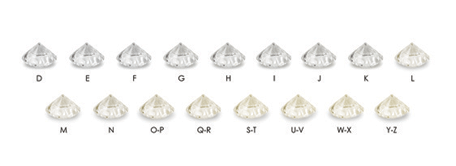
Gem experts judge the quality and value of a diamond by using 4 fundamental criteria. If you’ve been researching diamonds, then you’ll already know about the 4 Cs: Cut, Colour, Clarity and Carat weight. Below, we cover each criterion, with recommendations, so you can make a decision on what diamond is best for you.
1. How to choose diamond CUT


Cut refers both to the skill with which a rough diamond has been carved into a gemstone, as well as its overall decorative shape.
The cut is arguably the most important of the 4 Cs because the diamond’s sparkle depends on it.
It’s the only aspect of a diamond that relies solely on man, rather than nature. Only a skilled craftsman can cut and polish a rough stone into a beautiful diamond.


5 most common diamond cuts in order of sparkliness:
- Round diamonds are the sparkliest, followed by the square princess cut.
- Pear and marquise cut stones are quite sparkly, although not as much as round cuts and princess cuts.
- Rectangular diamonds (emerald and baguette cuts) give off long, sustained flashes of light, rather than sparkle.
⭐⭐⭐⭐⭐ OUR RECOMMENDATION: Always choose a cut that’s been graded as Good/Very Good to ensure beautiful lightplay. If you’re in doubt about the shape, you cannot go wrong with a classic round cut.
2. How to choose diamond COLOUR


All diamonds are graded by colour. This may sound confusing, as diamonds are transparent.
However, a very poor quality diamond will actually look yellowish.
Diamonds are judged on a colour scale from D to Z. This means that the best colour grade is D which is colourless, and the worst is Z which is very yellow:


⭐⭐⭐⭐⭐ OUR RECOMMENDATION: For solitaire diamonds under 0.50 carat, choose colour H. It’s within the white colour range so the naked eye cannot tell if there is any yellow in it. Additionally, it’s very affordable.
3. How to choose diamond CLARITY


Without clarity, a diamond will look dull and lifeless. What is clarity? Inside most diamonds, there are small mineral flecks or fractures. These naturally occurring marks are called inclusions.
The fewer inclusions a diamonds has, the better its clarity. The better the clarity, the rarer and more expensive the diamond.
Diamond clarity is measured in units – from IF (Flawless) which is the clearest, to I3 (Included) which is the least clear:


⭐⭐⭐⭐⭐ OUR RECOMMENDATION: If buying a diamond under 0.50 carat, stick within the range of SI2 (Slightly Included) to VS1 (Very Slightly Included) and you’ll get good value for money because you will not be able to see any imperfections with your naked eye.
4. How to choose diamond CARAT weight


We measure a diamond’s weight in carats. The more carats there are, the bigger the diamond.
There are 100 points in each carat. Meaning that if a diamond weighs 50 points, then it will be half a carat in size. This would be indicated as 0.50CT.
Below, you can see what a 1.00CT (one carat) diamond ring looks like on a woman’s hand.
⭐⭐⭐⭐⭐ OUR RECOMMENDATION: If you’ve chosen the cut, clarity and colour and have money left in your budget, now it’s time to go for more carats.
5. A couple more things worth considering…


Apart from the 4 Cs, we additionally like to remind diamond buyers about a further two Cs – certificates and conflict-free diamonds:
1. Certified diamonds
A certified diamond comes with a diamond report, also called a diamond certificate, from a gemmological institution such as the GIA or the IGI. A diamond report adds value by confirming your diamonds four Cs and other characteristics, plus proving ownership. Read more about diamond certificates here.
2. Conflict-free diamonds
Make sure you buy a conflict-free diamonds, sourced ethically. This means your diamond does not come from the black market, sold by illegal groups or terrorists that commit human rights violations. Read more about conflict-free diamonds here.
Visit our comprehensive Engagement Ring Learning Centre to find out more.
See all our engagement rings at TheDiamondStore.co.uk.
Discover more
- Diamonds: 5 Questions People Most Often Ask
- 7 Things You Need To Know About Lab Diamonds
- Lab Diamonds vs Mined Diamonds Price Comparisons
Share this:
Tags4 Cs • diamond • guide
Post navigation
Previous Post Previous Post Next Post Next Post
Ten articles before and after
How to Build a Jewellery Collection | CHURINGA RINGS
10 Best Diamond Bracelets and Bangles – Perfect gifts for any occasion | CHURINGA RINGS
10 Best Diamond Necklaces for Christmas | CHURINGA RINGS
10 Best Diamond and Gemstone Earrings for Christmas | CHURINGA RINGS
Meaning of Diamond Bangles – Significance, origin and occasions to wear | CHURINGA RINGS
Which Birthstone Is Yours? | TheDiamondStore Magazine | CHURINGA RINGS
What are sustainable diamonds? Everything about lab grown diamonds | CHURINGA RINGS
Guide to Buying Emeralds – 10 facts to help you shop with confidence | CHURINGA RINGS
Guide to Buying Rubies – 10 facts to help you shop with confidence | CHURINGA RINGS
Guide to Buying Topaz Jewellery – 10 Facts Topaz Gemstone | CHURINGA RINGS